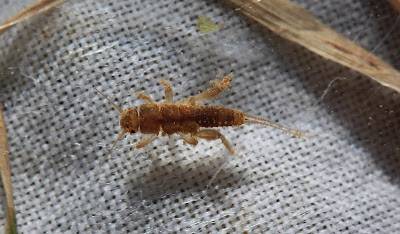Thursday, March 9, 2017
The Nemourid we find in our small mountain streams: genus Soyedina
As you can see this nymph was fully mature -- black wing pads -- and I guess I should have brought it home and tried my hand at rearing it. That's the only way to determine the species.
Nemourid stonefly, genus Soyedina. Let me read you Beaty's description. "Nymphs 6.5-8.5 mm. Pronotum with angulate corners and a distinct sublateral notch; pronotum with well-developed lateral fringe of short, closely set, thick setae; wing pads divergent; legs short, stout." ("The Plecoptera of North Carolina," p. 17)
This nymph was 8 mm long. You can see from our photo that the legs are short and stout. For the pronotum features -- all clear in this microscope photo.
The species is undetermined, but I guess that's true for almost all of the Soyedina that we're liable to find in our streams. There appear to be five different options: vallicularia, carolinensis, kondratieffi, washingtoni, and n. sp. (a new species, unnamed). That's why I should have given rearing a try. Have to see if I can find another next week. Location? One of our small headwater streams in Sugar Hollow. We've found them there before. I collected this one in December, 2013.
There is something quite distinctive about this nymph that may help with nymph descriptions: there are evenly spaced postero-lateral tubercles on terga 1-7.
I'm sending this one down to Beaty for further review. I'll let you know if he has any insights. Soyedina nymphs are "relatively rare."
_________________
The other insect I collected this morning was a tiny Uenoid -- Neophylax aniqua.
This is the Uenoid we find at high elevations. The distinguishing features are: 1) a semi-blunt tubercle on the head; 2) 1-3 setae at the ventral sa3 position; and 3) absence of clavate gills.
You can actually see the tubercle in one of my live shots.
But it's much clearer in this microscope view, a view that also reveals 2 setae at sa3.
_________________
Pretty good morning. Lots of insects in our streams at the moment.
Subscribe to:
Post Comments (Atom)









No comments:
Post a Comment